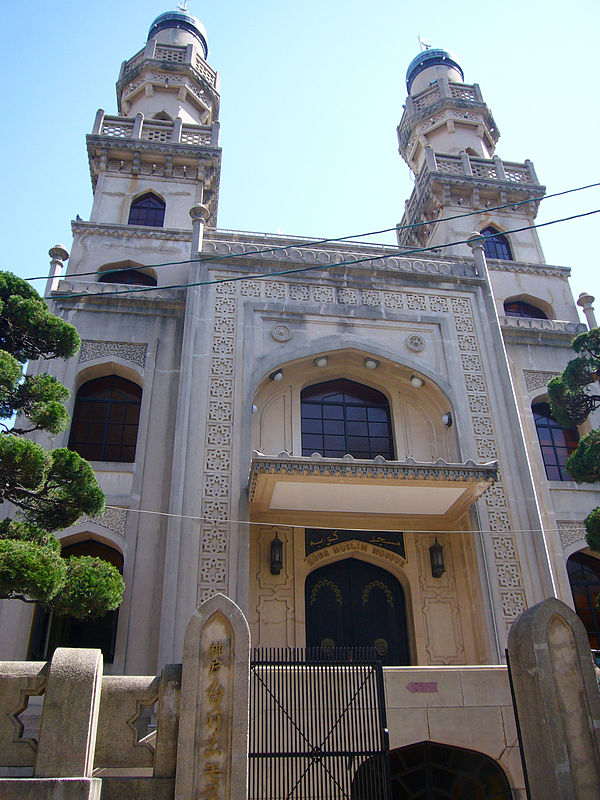Top Qs
Timeline
Chat
Perspective
Kobe Mosque
Mosque in Kobe, Hyōgo, Japan From Wikipedia, the free encyclopedia
Remove ads
The Kōbe Mosque (Japanese: 神戸モスク, romanized: Kōbe Mosuku), also known as the Kōbe Muslim Mosque (Japanese: 神戸ムスリムモスク, romanized: Kōbe Musurimu Mosuku, is a mosque located in Kōbe, in the Hyōgo Prefecture of Japan. Founded in October 1935, it is Japan's first mosque,[1] and holds historical significance as a symbol of the early presence of Islam in Japan.[2] Its construction was funded by donations collected by the Islamic Committee of Kōbe from 1928.[a] The mosque was confiscated by the Imperial Japanese Navy in 1943, survived airaids in 1945, and withstood the Great Hanshin earthquake of 1995.[4] It is located in the Kitano-cho foreign district of Kobe, one of the city's best-known tourist areas which features many old western style buildings.
The mosque was built in traditional Indo-Islamic style by the Czech architect Jan Josef Švagr (1885–1969), the architect of a number of Western religious buildings throughout Japan.
In addition to its architectural and historical significance, the mosque serves as a focal point for Japan's Muslim community. As of 2024[update], it was one of 113 mosques in Japan.[5]
Remove ads
History
The Kobe Mosque's construction, initiated by the Islamic Committee of Kobe in 1928, overcame financial and logistical hurdles. Confiscated by the Imperial Japanese Navy in 1943 during World War II, its restoration efforts epitomized resilience amidst wartime adversities, highlighting the community's commitment to their faith. Surviving the 1945 air raids largely unscathed, the Kobe Mosque emerged as a symbol of hope amidst devastation, showcasing its cultural and historical significance.[6] Similarly, during the Great Hanshin earthquake of 1995, though damaged, the mosque stood as a pillar of strength, continuing to serve as a vital center for worship, community, and resilience for Kobe's Muslim community and beyond.[7] Its endurance through these trials has earned it the moniker of the "Miracle Mosque."[8]
Remove ads
Architecture
Constructed in 1935 by the Takenaka Corporation,[9] the mosque has a reinforced concrete structure. Its architectural style is a fusion of traditional Asian-Turkish influences. Designed by renowned architect Jan Josef Švagr, the mosque features intricate patterns, domes, and minarets, symbolizing the cultural exchange between Japan and the Islamic world.[10]
Located at 2 Nakayamate Douri, Chuo-Ku, the mosque spans three levels above ground and one underground level. Its roofing comprises a combination of flat roofs and domes with wooden structures and copper roofing. The walls are finished with exposed-aggregate, adding to the mosque's aesthetic appeal.[11]
Remove ads
Community impact
The Kobe Mosque is a center for the local Muslim community in Kobe that serves as a place for worship and a focal point for various outreach programs and cultural events, for Muslims to engage with the broader community.[12] Its initiatives such as interfaith dialogues, language classes, and community service projects, help to promote understanding and collaboration among people of different cultural and religious backgrounds. The presence of the mosque helps to contribute to the multicultural identity of Kobe and serves as a symbol of diversity and inclusivity.[13]
Gallery
- An aerial view of the mosque in 1936, showcasing its early architectural grandeur and historical significance
- The prayer hall
See also
Notes
- Aga Khan III was a major contributor. He facilitated a meeting between the then East Pakistan Prime Minister and the Emperor of Japan to discuss the building of a mosque in Japan. The Emperor offered land for the mosque's construction.[3]
References
External links
Wikiwand - on
Seamless Wikipedia browsing. On steroids.
Remove ads





